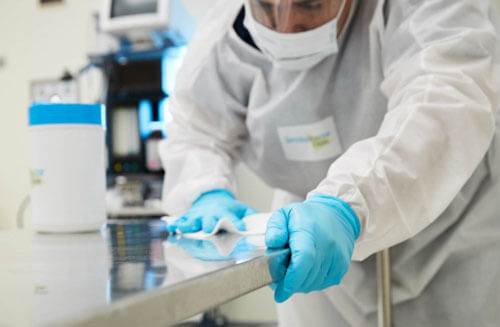
The residual contamination on the carrier after cleaning and disinfection poses a risk when enough infectious microorganisms can be transferred to individuals either to cause infection or to continue transmission indirectly through handling.
Environmental surfaces contaminated with pathogens can be sources of indirect transmission, and cleaning and disinfection are common interventions focused on reduziering contamination levels.
We determined the efficacy of cleaning and disinfection procedures forreduziering contamination by noroviruses, Rotavirus, Poliovirus, Parechovirus, influenza virus, Staphylococcus aureus, and Salmonella enterica from artificially contaminated stainless steel surfaces.
After a single wipe with water, liquid soap, or 250-ppm free chlorine solution, the numbers of infective viruses and bacteria were reduced by 1 log10 for Poliovirus and close to 4 log10 for influenza virus.
There was no significant difference in residual contamination levels after wiping with water, liquid soap, or 250-ppm chlorine solution.
When a single wipe with liquid soap was followed by a second wipe using 250- or 1,000-ppm chlorine, an extra 1- to 3-log10 reduktion was achieved, and except for rotavirus and norovirus genogroup I, no significant additional effect of 1,000 ppm compared to 250 ppm was found.
A reduced correlation between reduktion in PCR units ( PCRU) and reduktion in infektius particles suggests that at least part of the reduktion achieved in the second step is due to inactivation instead of removal alone.
We used data on infectious doses and transfer efficiencies to estimate a target level to which the residual contamination should be reduced and found that a single wipe with liquid soap followed by a wipe with 250-ppm free chlorine solution was sufficient to reduce the residual contamination to below the target level for most of the pathogens tested.